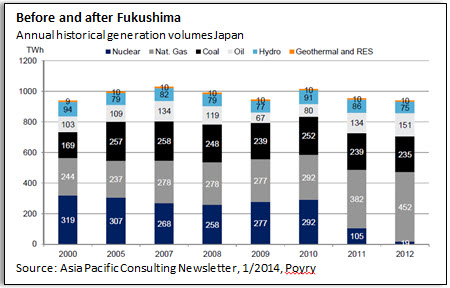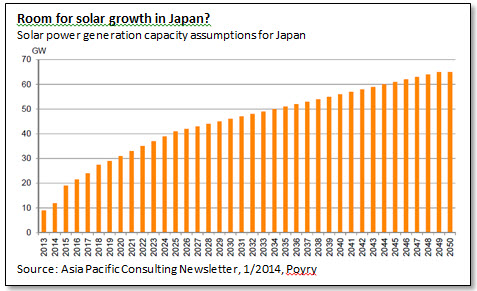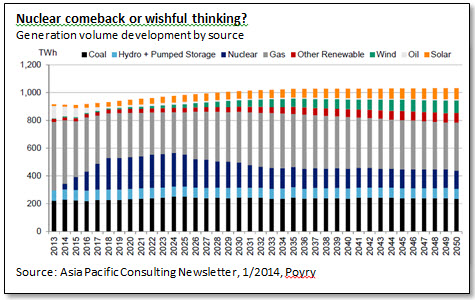Three years after Fukushima, Japan is still debating its energy future.
This is a sample article from the April 2014 issue of EEnergy Informer.
Three years ago on 11 March a devastating earthquake and tsunami hit Japan with unprecedented ferocity, wiping out entire coastal towns and demolishing Tokyo Electric Power Company’s (TEPCO) Fukushima Daiichi Nuclear Plant. The accident not only devastated the plant, but also the reputation and fortune of its owner and operator, TEPCO, once among the biggest privately owned global power companies.
The tremors had repercussions across the globe, including in Germany, where Chancellor Angela Merkel’s government decided to shut down half its operating reactors immediately with the remaining slated for phase out by 2022. A handful of other countries, Switzerland for example, said they will not replace their existing reactors once they retire. Italy, which had an on-again, off-again nuclear policy, turned it off again. Other countries had to go the drawing board, re-examining the safety and disaster preparedness of their reactors.

France and South Korea, both nuclear happy countries, have had second thoughts on how much nuclear they would want. The US and the UK, where both governments are trying to encourage more nuclear reactors built, are still mostly trying. China, on the other hand, appears to have not noticed that there was a major accident in Fukushima.
Nuclear experts — and non-experts — have, of course, been making all sorts of predictions on what the longer-term legacy of Fukushima may be. Christoph Frei, Secretary General of the World Energy Council (WEC), for example, in a prepared statement to commemorate the accident said,
“In our study on nuclear energy in March 2012, we found that Fukushima had had limited impact on the global nuclear outlook and this was particularly so for non-OECD countries. But two years on, the situation has evolved. The market attractiveness of nuclear energy has now been undermined by the availability of cheap natural gas, collapsing solar prices, uncertainty of CO2 prices, along with nuclear energy’s rising safety-related costs. This will have significant consequences for our ability to deliver a diverse fuel mix for a secure, affordable and environmentally sustainable energy future.”
President Obama, who must have learned the difference between what he wants and what he may be able to achieve, frequently refers to US energy strategy as all of the above, which suggests a mixture of fossil fuels, nuclear and a growing contribution from renewable resources. As it turns out, that is more or less what politicians in Japan also appear to be pursuing — assuming they can keep nuclear as a viable option in their future energy mix.
For Japan, a resource poor island nation in a region increasingly competing for imported liquefied natural gas (LNG) with South Korea and coal with both Korea and China, keeping the nuclear option alive is a top priority and a sensible one — if it were not for the growing public opposition to nukes, which gained momentum following Fukushima.

Following the accident all of Japan’s nuclear reactors were shut down for safety reasons (graph above). Only 2 have restarted, you might say, for symbolic reasons while 46 GW of nuclear capacity is sitting idle awaiting safety reviews. TEPCO’s abysmal record in managing the aftermath of the accident and the way it has handled — or mishandled — communications with the public has not helped to smooth the public’s uneasiness about the future safety of reactors in a country sitting on tectonic faults.
Successive governments have had different views on the future role of nuclear energy. The current Prime Minister, Shinzō Abe, is pro-nuclear and has proposed to gradually re-start the existing reactors that are deemed to be safe, and if all goes well, build a few more, but not as many as were envisioned before Fukushima.

Not everyone agrees. The anti-nuclear lobby, pointing to the industry’s past spotty record and lack of transparency, says neither the operators nor their watchdog can be trusted. Moreover, the lights have miraculously stayed on despite the near-total nuclear shut-down. Why not move forward by phasing out all remaining reactors, as in Germany, relying on more energy efficiency and renewables, the anti-nuclear lobby asks?
If Germany, a major industrial powerhouse can do it, why not Japan? There is certainly a lot of future potential for more renewables. Japan is blessed with hydro, geothermal, wind, solar and tidal resources. The problem, as in many other countries, is their intermittency and, in the case of Japan, the mountainous topography making it challenging for a densely populated country consisting of several major islands with poor transmission interconnections operating on two frequencies, a historical oddity.

According to Poyry, a consultancy, Japan’s solar capacity, currently around 10 GW, may be increased to 60 GW by 2050, give or take some (graph above). Given that total demand is not projected to grow much over time — Japan is a mature economy like other advanced OECD countries — one can envision a future with a more diverse generation portfolio (graph on left), potentially limping along without any nuclear plants.
As Japan’s recent experience has demonstrated, a future without nuclear is not inconceivable. The question is, would it be desirable, reliable, and ultimately affordable? Germany is likely to find out. Japan is yet to decide.

